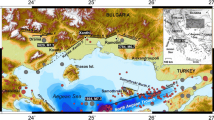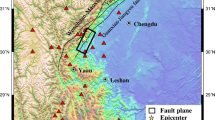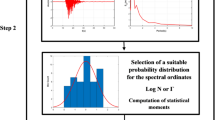Abstract
This study presents estimates of bedrock level peak ground motion at 2346 sites on a regular grid of 0.2° × 0.2° in northwestern (NW) Himalaya from 543 simulated sources, using the stochastic finite-fault, dynamic corner frequency method, with particular emphasis on Kashmir Himalaya. The earthquake catalogue used for simulating synthetic seismograms is compiled by including both pre-instrumental and instrumental era earthquakes of magnitude Mw ≥ 5, dating back to 260 AD. Acceleration time series thus generated are then integrated to obtain velocity and displacement time series, which are all used to construct a suite of hazard maps of the region. Expected PGA values for the Kashmir Himalaya and Muzaffarabad are found to be ~ 0.3–0.5 g and for the epicentral region of the 1905 Kangra event, to be 0.35 g. These values are consistent with other reported results for these areas e.g., Khattri et al. (Tectonophysics 108:93–134, 1984) and Parvez et al. (J Seismol, 2017. https://doi.org/10.1007/s10950-017-9682-0). The PGA values estimated in this study are in general found to be higher than those implied by the official seismic zoning map of India produced by the Bureau of Indian Standards (BIS in Indian Standard criteria for earthquake resistant design of structures part 1 general provisions and buildings (Fifth Revision), vol 1, no 5. Indian Standard, 2002). Even the acceleration-derived intensities for most regions are found to be higher compared with those observed, which apparently is due to the use of a longer duration catalogue (260 AD–2016) for simulation not covered by the observed intensity catalogue and higher magnitude ascribed to historical events. Major events in Kashmir Himalayas, such as those of 1555, 1885 and 2005, are simulated individually to allow comparison with available results. Simulated pseudo-acceleration and velocity response spectra for three sites near the 2005 Kashmir earthquake for which site conditions were available (Okawa in Strong earthquake motion recordings during the Pakistan, 2005/10/8, Earthquake, 2005. https://iisee.kenken.go.jp) are compared with observed spectra. This study provides a first-order ground motion database for safe design of buildings and other infrastructure in the NW Himalayan region.








Similar content being viewed by others
References
Aki K (1967) Scaling of the seismic spectrum. J Geophys Res 72(4):1217–1231
Aki K (1987) Strong motion seismology. In: Erdik M, Toksz MN (eds) Strong ground motion seismology. Springer Netherlands, Dordrecht, pp 3–39. ISBN 978-94-017-3095-2
Aki and Richards (2002) Quantitative seismology, 2nd edn. University Science Books, Mill Valley
Ambraseys NN, Bommer JJ (1991) The attenuation of ground accelerations in Europe. Earthq Eng Struct Dyn 20:1179–1202. https://doi.org/10.1002/eqe.4290201207
Ambraseys NN, Douglas J (2004) Magnitude calibration of north Indian earthquakes. Geophys J Int 159(1):165–206
Arya AS (1990) Damage scenario of a hypothetical 8.0 magnitude earthquake in Kangra region of Himachal Pradesh. Bull Indian Soc Earthq Technol 27(3):121–132
Bendick R, Bilham R, Khan MA, Khan SF (2007) Slip on an active wedge thrust from geodetic observations of the 8 October 2005 Kashmir earthquake. Geology 35(3):267–270. https://doi.org/10.1130/G23158A.1
Berckhemer H (1962) Die ausdehnung der bruchflächeimerdbebenherd und ihreinflussauf das seismischewellenspektrum. GerlandsBeitr Geophys 71:5–26
Bhatia SC, Kumar MR, Gupta HK (1999) A probabilistic seismic hazard map of India and adjoining regions. Ann Geofis 6:1153–1164
Bilham R (2019) Himalayan earthquakes: a review of historical seismicity and early 21st century slip potential. In: Treloar PJ, Searle MP (eds) Himalayan tectonics: a modern synthesis. Geological Society of London, London. https://doi.org/10.1144/SP483.16
BIS. IS 1893 (Part 1) (2002) Indian Standard criteria for earthquake resistant design of structures part 1 general provisions and buildings (Fifth Revision), vol 1, no 5. Indian Standard, New Delhi
Boore DM (2003) Simulation of ground motion using the stochastic method. Pure Appl Geophys 160(3):635–676. https://doi.org/10.1007/PL00012553
Boore DM (2009) Comparing stochastic point-source and finite-source ground-motion simulations: SMSIM and EXSIM. Bull Seismol Soc Am 99(6):3202–3216
Boore DM, Thompson EM (2014) Path durations for use in the stochastic-methodsimulation of ground motions. Bull Seismol Soc Am 104(5):2541–2552
Brandt A, Brincker R (2014) Integrating time signals in frequency domain—comparison with time domain integration. Measurement 58:511–519
Chandra U (1978) Seismicity, earthquake mechanisms and tectonics along the Himalayan mountain range and vicinity. Phys Earth Planet Inter 16:109–131
Chen C-T, Chang S-C, Wen K-L (2017) Stochastic ground motion simulation of the 2016 Meinong, Taiwan earthquake. Earth Planets Space 69(1):62
CIESEN (2018) Center for International Earth Science Information Network, Columbia University. Gridded Population of the World, Version 4 (GPWv4): population count, revision 11. NASA Socioeconomic Data and Applications Center (SEDAC), Palisades. https://doi.org/10.7927/H4JW8BX5. Accessed 01 Mar 2020
Dhanya J, Gade M, Raghukanth STG (2017) Ground motion estimation during 25th April 2015 Nepal earthquake. Acta Geod Geophys 52:69–93. https://doi.org/10.1007/s40328-016-0170-8
Gallovič F, Burjanek J (2007) High-frequency directivity in strong ground motion modeling methods. Ann Geophys 50(2):203–211
Giardini D, Gruenthal G, Shedlock K, Zhang P (1999) The global seismic hazard map. Ann Geofis 42(6):1225–1230.
Jones EA (1885) Report on the Kashmir earthquake of 30th May 1885. Rec Geol Soc India 12(4):221–227
Joyner WB, Boore DM (1981) Peak horizontal acceleration and velocity from strong motion records including records from the 1979 Imperial Valley, California, earthquake. Bull Seism Soc Am 71:2011–2038
Kaneda H, Nakata T, Tsutsumi H, Kondo H et al (2008) Surface rupture of the 2005 Kashmir, Pakistan, earthquake and its active tectonic implications. Bull Seismol Soc Am 98(2):521–557
Khalid P, Bajwa AA, Naeem M, Di ZU (2016) Seismicity distribution and focal mechanism solution of major earthquakes of northern Pakistan. Acta GeodGeophys 51:347–357
Khattri KN (1999) Probabilities of occurrence of great earthquakes in Himalaya. Curr Sci 77(7):967–972
Khattri K, Rogers A, Perkins D, Algermissen S (1984) A seismic hazard map of India and adjacent areas. Tectonophysics 108:93–134
Kolathayar S, Sitharam TG, Vipin KS (2012) Deterministic seismic hazard macro-zonation of India. J Earth Syst Sci 121(5):1351–1364
Kuchay NA, Bhat MS (2014) Analysis and Simulation of urban expansion of Srinagar City. Transt Inst Indian Geogr 36(1):109–121
Kumar S, Wesnousky SG, Rockwell TK, Ragona D et al (2001) Earthquake recurrence and rupture dynamics of Himalayan Frontal Thrust, India. Sci Mag 294:2328–2331
Lliboutry L (2000) Quantitative geophysics and geology. Springer, London, 1st edn. ISBN 978-1-85233-115-3
Mahajan AK, Thakur VC, Sharma ML, Chauhan M (2010) Probabilistic seismichazard map of NW Himalaya and its adjoining area, India. Nat Hazards 53(3):443–457. https://doi.org/10.1007/s11069-009-9439-3
Martin S, Szeliga W (2010) A catalog of felt intensity data for 570 earthquakes in India from 1636 to 2009. Bull Seismol Soc Am 100(2):562–569
McGuire RK (2004) Seismic hazard and risk analysis. EERI. ISBN 0943198011
Menon A, Ornthammarath T, Corigliano M, Lai CG (2010) Probabilistic seismic hazard macrozonation of Tamil Nadu in Southern India. Bull Seismol Soc Am 100(3):1320–1341
Mir R (2020) Crustal structure and quantified earthquake hazard in the North Western Himalaya. Dissertation, Academy of Scientific and Innovative Research, New Delhi, India
Mittal H, Kumar A (2015) Stochastic finite-fault modeling of Mw 5.4 earthquake along Uttarakhand-Nepal border. Nat Hazards 75(2):1145–1166
Mohadjer S, Ehlers TA, Bendick R, Stübner K, Strube T (2016) A quaternary fault database for central Asia. Nat Hazards Earth Syst Sci 16:529–542. https://doi.org/10.5194/nhess-16-529-2016
Motazedian D, Atkinson GM (2005) Stochastic finite-fault modeling based on a dynamic corner frequency. Bull Seismol Soc Am 95(3):995–1010.https://doi.org/10.1785/0120030207
Okawa I (2005) Strong earthquake motion recordings during the Pakistan, 2005/10/8, Earthquake.Technical report. https://iisee.kenken.go.jp
Panjamani A, Bajaj K, Moustafa SS, Al-Arifi NS (2016) Relationship between intensity and recorded ground-motion and spectral parameters for the Himalayan region. Bull Seismol Soc Am 106(4):1672–1689
Panza GF, Romanelli F, Vaccari F (2001) Seismic wave propagation in laterally heterogeneusanelastic media: theory and applications to seismic zonation. Adv Geophys 43:1–95
Parvez IA, Gusev AA, Panza GF, Petukhin AG (2001) Preliminary determination of the interdependence among strong-motion amplitude, earthquake mangnitude and hypocentral distance for the Himalayan region. Geophys J Int 144(3):577–596
Parvez IA, Vaccari F, Panza GF (2003) A deterministic seismic hazard map of India and adjacent areas. Geophys J Int 155(2):489–508
Parvez IA, Magrin A, Vaccari F, Ashish, Mir RR et al (2017) Neo-deterministic seismic hazard scenarios for india—a preventive tool for disaster mitigation. J Seismol. https://doi.org/10.1007/s10950-017-9682-0
Rodriguez-Marek AD, Bray J, Abrahamson N (2001) An empirical geotechnical seismic site response procedure. Earthq Spectra 17(1):65–87
Rout MM, Das J, Kamal, Das R (2015) Probabilistic seismic hazard assessment of NW and central Himalayas and the adjoining region. J Earth Syst Sci 124(3):577–586. https://doi.org/10.1007/s12040-015-0565-x
Sapkota SN, Bollinger L, Klinger Y, Tapponnier P et al (2013) Primary surface ruptures of the great Himalayan earthquakes in 1934 and 1255. Nat Geosci 6(1):71–76. https://doi.org/10.1038/ngeo1669
Scordilis EM (2006) Empirical global relations converting MS and mb to moment magnitude. J Seismol 10(2):225–236. https://doi.org/10.1007/s10950-006-9012-4
Sun X, Hartzell S, Rezaeian S (2015) Ground-motion simulation for the 23 August 2011, Mineral, Virginia, earthquake using physics-based and stochastic broadband methods. Bull Seismol Soc Am 105(5):2641–2661
Wells DL, Coppersmith KJ (1994) New empirical relationships among magnitude, rupture length, rupture width, rupture area, and surface displacement. Bull Seismol Soc Am 84(4):974–1002
Wiemer S (2001) A software package to analyse seismicity: ZMAP. Seism Res Lett 72(2):373–382. https://doi.org/10.1785/gssrl.72.3.373
Yeats RS, Thakur VC (1998) Reassessment of earthquake hazard based on fault- bend fold model of the Himalayan plate-boundary fault. Curr Sci 74(3):230–233
Zuccolo E, Vaccari F, Peresan A et al (2011) Neo-deterministic and probabilistic seismic hazard assessments: a comparison over the Italian territory. Pure Appl Geophys 168:69–83. https://doi.org/10.1007/s00024-010-0151-8
Acknowledgements
The authors would like to thank Prof. Vinod Gaur for his valuable comments and suggestions. We also acknowledge the continuous support provided by the Head, CSIR-4PI. We would also like to thank Dr. Stephan Crane for help on EXSIM12 algorithm. Sincere thanks to Prof. Thomas Glade and Prof. V. Schenk Editors-in-Chief at the Natural Hazards for their support. Comments from two anonymous reviewers helped a lot in improving this manuscript to its current shape. We acknowledge the financial support from Ministry of Earth Sciences (MoES), Government of India, via project number MoES/P.O.(Geosciences)16/2013 (GAP-1010). RM was also supported by Senior Research Fellowship from the Council of Scientific and Industrial Research (CSIR), New Delhi, India.
Author information
Authors and Affiliations
Corresponding author
Ethics declarations
Conflict of interest
The authors declare that they have no conflict of interest.
Additional information
Publisher's Note
Springer Nature remains neutral with regard to jurisdictional claims in published maps and institutional affiliations.
Both authors contributed equally to this work.
Electronic supplementary material
Below is the link to the electronic supplementary material.
Rights and permissions
About this article
Cite this article
Mir, R.R., Parvez, I.A. Ground motion modelling in northwestern Himalaya using stochastic finite-fault method. Nat Hazards 103, 1989–2007 (2020). https://doi.org/10.1007/s11069-020-04068-8
Received:
Accepted:
Published:
Issue Date:
DOI: https://doi.org/10.1007/s11069-020-04068-8




